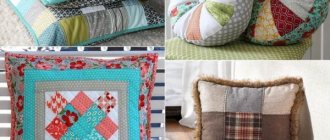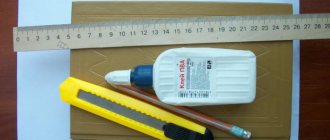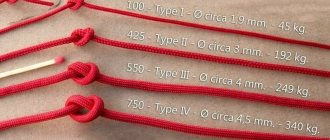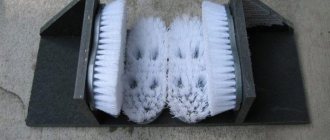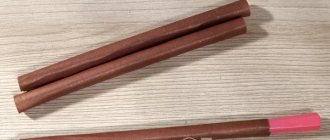It is important to properly preserve valuables and money and reliably protect them from theft. The first thing that comes to mind in such a situation is to purchase ready-made hiding places and safes, mounted into the wall and stylized as a painting, for example. But the fact is that it is precisely such items that are immediately at risk. Therefore, we offer you some clever and simple ideas on how to make a hiding place at home with your own hands. To do this, we will use ordinary everyday things that will certainly not arouse the suspicion of robbers.
Hiding places for houses and apartments.
Sockets
No thief would risk his life for money. Therefore, it would never even occur to him to poke his nose into electrical sockets. Turn off the electricity in the house and remove the plastic cover. A big enough hole will appear in front of you into which you can put your savings. There is one more life hack. If you plan to change the wiring in your apartment, make one false outlet. It may look like everyone else, but there will be no wires connected to it. This stash can be used all the time, and not just when you leave home and the power might go out. The thief will have no time to check all the sockets for the presence of current in them, and your wealth will be safe.
A hiding place for money where it is not customary to look
A hiding place in an apartment can be made in places where it would be extremely unpleasant for a thief to look for it.
In places that are not the first freshness, there is a basket with dirty laundry: socks, underwear, etc. Rummaging through it is not pleasant and not interesting, this is the last place where thieves, of course, can also look if they do not find anything valuable in the house.
The hiding place is in a book, but not in a simple book, but in the criminal code. It will work if it stands among many other books, preferably on a similar topic. The subconscious fear of the ill-wisher may well work and he will not touch the “scary” book.
Other interesting articles:
Studio apartment design - photos of the latest projects!
Wall decoration with fabric - photo 2022 cozy drapery for the interior.
18 wooden lamps from people with great imagination
Many experienced people advise that in order to save a larger amount, you should make a second distracting hiding place. More affordable. Having found it, the thieves may well calm down and leave the crime scene. Unless, of course, they know about the presence of more valuable things in the house.
Toilet
Surely you immediately thought of placing a bag of money and jewelry in the drain tank. This hiding place is already known to thieves, so there is no point in taking risks. You need to use a float that regulates the water level. Turn off the water, carefully remove it from the tank and cut it to make a storage container (for example, a pretty decent rolled up wad of money will fit in there). After this, glue the cut improvised lid with superglue or weld it using a lighter or soldering iron (the heated parts of the plastic will easily melt and stick).
Pipes
There is nothing easier than hiding valuables in the most unexpected place. Thieves will never think of looking for your savings where nothing disturbs the natural environment. Therefore, pay attention to the pipes that are located in the toilet or bathroom (preferably in the toilet, since there are more of them there). Buy exactly the same piece of pipe in the store or take the one that was left over from the repair. Place your savings there and attach them to real pipes. Rest assured that robbers simply won’t have time to check all the pipes for the presence of water. Just don’t forget where your cache is, since finding it will be problematic even for experienced detectives.
Making a cache
So, there is something to hide. Next you need to decide from whom:
- From your family - not so easy, because... time for searches and guesses is unlimited.
- From thieves - you need to make sure that it takes as much time as possible to guess where it is and/or break in.
- From legal search officers - the hardest thing, but for contents up to 0.5-1 cubic meters. dm in some cases possible, see below.
Where to hide
There is not so much space in the house for a hiding place, taking into account the savvy nature of possible searchers. Further, the storage facility should not spoil what is stored. And if we also take into account that creating a mechanism for a hiding place requires not only technical education and experience, but also special talent, then the possibilities for creating a “hidden hole” turn out to be even less. However, you can still make a fairly reliable hiding place from your own people and thieves with your own hands without experience:
- In household appliances;
- In furniture;
- In building structures, fixed and movable;
- In the floor;
- In unexpected places.
Let’s go in this order, not forgetting about the limitations of the technical capabilities of setting up a hiding place at home; eg You can’t litter or make a lot of noise, unless the hiding place is made as a DIY repair. A hiding place that two people know about is no longer a hiding place.
Bytovukha
Usually recommended for setting up a hiding place are old TVs or, for example.
The niches behind the false socket are absolutely unreliable. The owner needs to keep them in a believable form, but the thief does not. They have phase indicators, just like the legal ones. Poke - there is no phase, the probe does not go completely into the hole. This means there is a niche with something interesting. Then - a jerk with a crowbar, and everything hidden is in plain sight. The lid of an old TV can be pulled off in the same way, but there is no need to check the network. The best hiding place in household appliances for money is the refrigerator. Just don’t spoil its inner lining and thermal insulation. After reading the refrigerator repair manuals, you will see that there is plenty of free space. In some models, behind the compressor you can hide up to 3-4 wrapped packs (“presses”) of 100-dollar bills, which is 300-400 thousand bucks. But the refrigerator will work as if nothing had happened. The air conditioning is worse: there is almost no space in the indoor unit. The washing machine is also not very good: there is a decent amount of space, but what is stored can get wet. And you can’t store jewelry in all of them, they can short-circuit electrical circuits or damage the mechanics, and that’s why they themselves fall apart.
Here’s an example of a non-trivial approach: we buy a shabby case of an old computer from the Pentium II era and later, and a 5” floppy drive for it. All the stuffing of a modern desktop PC moves into the case of the “second stump” of its immediate descendants without any problems. Then – the flop guide. Its chassis is a silumin tub in a tin casing, partitioned horizontally into 2 compartments. In the lower shallow one there is a board with electronics and connectors, we leave it. In the upper, larger part there are mechanics, spindle and stepper motors, read-write heads. We delete all this; We cut the wiring harnesses onto the board and slightly fray them (from a short circuit) so that there are no empty slots for connectors on the board. A niche is formed approx. 1 cu. dm. We put the casing back, the floppy drive into the case, connect it (nothing will happen to the computer, especially if you turn off the floppy drive in the setup) - an unclickable and non-transparent cache is ready. The computer works as always. Why is the body like this? I bought it a long time ago and upgraded it little by little. Floop drive not working? It’s old, it’s broken, I’m holding it like a plug. Nowadays you can only find soft floppy disks in a museum.
Furniture
Furniture hiding places are as old as time and are just as well known to seekers. As for trivial solutions, let us recall some of the hidden classics. First, the nests in the legs of the furniture must be made at the top (on the left in the figure), otherwise the hiding place will open up on its own and the leg will break. Second, the secret compartment in the closet should also be at the top (in the center), so finding it by tapping or measuring will take much more time and will be very inconvenient to operate. And on the right in Fig. - a classic way to create a hiding place for your family. For reliability, you can cover it with plywood; it is held on by shoe Velcro.
Secrets in furniture
From parents…
Teenagers most often hide their secrets from their parents in chairs, behind the bottom covers of pianos, and in furniture in general. These are, in general, the inevitable “brain cockroaches” of puberty; Let's hope that what is stored is harmless to health and psyche. In this case, in addition to the known and obvious, something else will benefit mental development.
First, there is no need to hide anything in cabinet upholstered furniture: it is involuntarily, but inevitably, felt by the “fifth point” or the back of those sitting. But if there is a bean bag chair in the house, then it can easily be used as a hiding place, reliable from thieves, and even, if the search time expires according to the law, from legals. The zipper on the decorative cover opens, the seam of the technical fabric container with fluffy filler granules is cut, and something is hidden in its thickness. Then, to prevent the filler from crawling out of the container and giving everything away, 3-4 pairs of clothing hooks or halves of Velcro tape are sewn to the edges of the opened seam. That's all. The introscope does not illuminate such a container; the mass of the filler absorbs any radiation and vibration.
Arrangement of hiding places in desk drawers
A trivial option for a hiding place in a table is behind shortened drawers, which is visible to the eye and without measurements. A non-trivial option for those who are tougher is shown in Fig. The classic hiding place in a desk drawer is a false bottom, but why not apply the “do the opposite” principle and create a false bottom? The bottoms of table drawers are secured either with cranial bars (top left) or mortise into drawers (bottom left). The skull bars are trimmed to create 5 mm of free space, and false bars are glued to the mortise bottom using the same calculation. The rest is clear from Fig. To be safe, it is better to keep all the boxes secret so that the difference cannot be detected by measuring and tapping. When necessary, remove the false bottom by picking it out with a screwdriver.
and from thieves...
Closet shelves are considered fairly reliable storage areas from thieves of money, credit cards and small jewelry. The time factor is at work here: turning over the junk in the closet is not a matter of minutes, and most often there is not enough time to tap the shelves. Making a hiding place in a closet shelf is quite simple:
- The shelf board is removed from the shelf holders.
- A series of blind holes - deep holes - are drilled into the back edge of the board.
- Jumpers of wood or chipboard between the holes are selected with a chisel.
- The cache is filled, the shelf is put in place.
- If the free space of the hiding place is also filled with absorbent material (see below, about hiding places in the floor), then it will be difficult to detect even by tapping.
Doors, walls, windows
A description of the hiding place in the door is widely circulated on the RuNet, see fig. It's witty, there's nothing to say. But only for a stash from my wife, and even then if she doesn’t go on the Internet and hasn’t read those articles: this hiding place can be easily detected either by knocking or by a simple metal detector that you can make with your own hands.
Simple hiding place in the door
Much more reliable, with the same or greater capacity, is a hiding place in a niche of the castle; best of all - in the niche of the interior door latch, see next. rice. The latch is chosen with a shorter mechanism, and its niche is deepened as much as possible without compromising the strength of the door. If it is necessary to protect against translucency, a spring steel bracket is tightly placed on the latch body. Its height should be equal to the height of the latch body, but there should be a small space left behind the bracket: searchers know that locks are not placed point-blank in niches.
Hiding place in the door lock niche
It is more difficult to arrange a hiding place in the wall; as a rule, this is done during construction or major renovation. The optimal option for a hidden treasure is a plasterboard partition on a frame made of steel C- and U-profiles: what is stored in their gutters cannot be detected by tapping or scanning. For a hiding place of this type that is easily accessible to the owner, but difficult to detect by outsiders, use a plasterboard ceiling. The technological hatch(es) in it will not cause suspicion; The sheathing gutters face upward, but the capacity of such a hiding place is enormous: an additional load of 10 kg/sq. m will not affect the strength of the false ceiling in any way, and $1,000,000 in new hundred dollar bills weighs exactly 6.5 kg. If you unpack the money, roll it up into tubes, push it away and sprinkle it with dust from a vacuum cleaner, then the contents will not be revealed even by a quick inspection, and for a search with dismantling of building structures, very, very compelling reasons are needed.
Cavities in plastic profile
Finally, a hiding place at home can be arranged in various types of plastic profiles; there are more than enough cavities in them, see fig. on right. Transillumination reveals such hiding places, but they are indistinguishable by knocking. The best option here is mosquito nets. A modern mosquito net on a frame made of plastic profiles weighs 3-5 kg and, if necessary, can be easily disassembled and then reassembled. An increase in its weight by 1.5-2 kg is not felt - there is dust and moisture. This means that the same $1,000,000 will fit in the frames of 3-4 nets, and 3 or more mosquito nets per apartment is normal.
Floor
A cache in the floor is the most difficult to equip, but its capacity in both volume and weight can be large. The main thing here is to know the properties of the materials well and select them so that the cache does not get tapped and does not stand out in the scanner image when scanned. An example of a non-trivial approach is that both thieves and special officers know: it is impossible for an amateur to set up a hiding place in a house on the floor of a house with reinforced concrete floors. It turns out that it is possible if the floor is insulated or there is a high screed on the ceiling. How? See fig. The anti-acoustic properties of marmoleum are widely advertised, and filling the cache above the contents will blur the introscope image.
Cache in the floor
Unusual
In unusual places it is common (pun intended) to set up a mini hiding place; most often - carried with you. Since the advent of credit cards, only a very stupid prostitute could gut a client's wallet without taking it away to examine it for a secret pocket. What should you do if you need a stash on a trip for an emergency or need to secretly smuggle a carrier with valuable information? At least the same credit card?
We take our own, i.e. slightly worn shoes, not tempting to thieves and not conspicuous. We take out the laces and bend the tongue. We put our hand into the very sock and carefully tear off part of the insole. So the cache is ready for a couple of large banknotes or a credit card.
For long-term storage of the same money or, say, a piece of paper with passwords and logins at home, an old spy cache made of a pencil with an eraser is suitable:
- Carefully remove the knob with the eraser by swinging it with your hand.
- We insert a drill with a diameter of 3.5-4 mm into a hand-held driver (a driver for taps is suitable) or wrap its shank with electrical tape so that it can be rotated smoothly with force.
- Drill a hole along the lead to the required depth.
- We roll up the piece of paper and put it in the hiding place.
- We put the knob with the eraser in place and lightly compress it with pliers. The pencil writes and can be erased with an eraser.
Cache in a cactus
But here is a completely unusual option. This hiding place can be seen through and pierced with a probe, but is quite reliable from the family. This is... a living cactus, see fig. on right. Cacti are very hardy, there is nothing vitally important in their core, there is only water-storing tissue. This is what is cut out to create the cavity of the hiding place. You will have to sacrifice part of the bottom with several roots, but cacti can withstand such damage, everything will grow back. We plant it back in the pot - it will continue to live, grow, even bloom. You just need to place the contents in a moisture-proof and chemical-resistant container: cactus juice is not water.
And finally - such a thing as a wearable cache for the beach. Stored items – keys, wallet, all sorts of trinkets. A beach cache is in some ways a reverse cache: it must be large enough so that the small contents do not get lost in the sand. And, when thinking about its design, you need to take into account that beach thieves have much less time for “business” than burglars, and they need to “get away” quickly and far away. One example of a successful solution to such problems is a bottle cache, see fig. below. You can pour a little of the drink from the label into the lower part from a syringe. Who needs other people's sawdust?
Bottle stash
Other simple options for beach hiding places are also possible, see for example. track. video:
Video: DIY beach cache
Cushioned furniture
People often hide money in furniture, and specifically under the upholstery. And almost all thieves know about these hiding places. So you should do things differently. If foam is used as filling, carefully remove the upholstery and make a cut in the foam. Stick your hand in there and cut out a hiding place deep directly into the foam itself. Place valuables there, the upper part of the foam will close, and the holes, and especially the recesses, will not be visible. After this, attach the upholstery using a stapler. Surely it would not occur to thieves to “gut” all the furniture, including not only the upholstery, but also all the filling.
Modern modular systems
Furniture modules can also be used as an additional room or even several to create not only comfortable and multifunctional housing, but also original interior design. Where there will be no clutter of all kinds of furniture and unnecessary partitions.
If you don’t have the opportunity to have a secret room, but really want to, you can even convert a piano to create your own relaxation area without disturbing the overall harmony of the interior.
You, too, can try to make your dream come true by creating at least a small, but your own hidden corner using an ordinary closet.
Did you like the article? Then support us, click
:
Cornice
If your home does not have round curtain rods (very often these are used in certain interior design styles), pay attention to the curtain rod that holds the curtain in the bathroom. Such a “pipe” will definitely be hollow inside, so there is nothing easier than removing the side holder and placing a rolled up stack of bills in the ledge. Since it is possible to fold valuables on both sides, be sure to take advantage of it (for example, you can fold not only money, but also jewelry placed in a small bag or pouch).
Sideboard, buffet or wardrobe
They skillfully hide the entrance to secret rooms or hide some interior items.
Children's rooms can be decorated in a particularly original and multifunctional way; here the fantasies of not only children, but also adults are realized!
Fridge
The refrigerator door closes tightly because there are magnets around the perimeter. There is a rubber braid on top. Carefully pull back the braid and make a small cut, removing some of the magnets that are divided into segments. Place your savings into a cavity made of thin material (you can even break it with your hands) and cover the hole with braid. Even if thieves are tempted by the refrigerator, they still will not find your well-hidden hiding place in it. This is a joke, since the refrigerator is an electrical appliance that is rarely taken out during a robbery. There is another advantage of this cache. You can easily use the refrigerator in your hotel room if the hotel does not have a safe for storing money. And don’t feel guilty, because, firstly, you didn’t damage the property (the refrigerator will still work and close tightly). And secondly, the hotel management must take care of the safety of the property of its guests. And if it doesn't, then guests have to worry about themselves.
How to store money: modern options
A modern way to hide savings or savings is to transfer them to a non-cash format. Today there are many ways to store money:
- On an electronic wallet. Registering such a wallet is very easy, you don’t need to go anywhere, and replenishing it is also very easy. In our country, electronic money such as WebMoney, Qiwi and YuMoney are popular. They are easy to use and you can rest assured of their safety.
- Mobile account. Mobile operators provide this type of service as a mobile account, from which you can pay for various purchases. This is also a very convenient way to store money. It’s convenient to hide savings in your mobile account even from bailiffs.
- Credit card. If you need to hide some part of your income from your husband or wife, a credit card is a good option. It provides all the same opportunities as a plastic card linked to a bank account.
- Bank deposit. This method of storing money is also a completely reliable way to protect it from thieves or an unreasonable spouse. The main thing is to choose a reliable bank.
Unfortunately, for a variety of reasons, storing money electronically is not convenient for everyone. This is especially true when you need to hide money while traveling, for example, on vacation.
A mattress and pillows are the first thing that comes to mind if you need to hide money
Food
There is nothing easier than hiding money or jewelry in a pot of food. Try to make sure that this pan is not the only one there. If there are a lot of other utensils in the refrigerator, it is unlikely that a thief will check all the cereals, soups and borscht (the dish should be opaque) for the presence of a hiding place. And if you turn off the power and the food spoils (becomes covered with a layer of mold), you can leave one pan. Robbers also have a sense of disgust, so they will not look for money with their hands in this fetid liquid. The downside is that you will then have to ventilate the kitchen and wash the pan. However, this is nothing compared to the safety of your savings.
Option three. I don't trust anyone, it's better to do it yourself
The best way to keep a secret place a secret is to arrange it yourself. It’s not that difficult, the main thing is to show maximum ingenuity and creativity so that the secret does not become obvious. Before considering possible options for homemade hiding places, estimate the size and number of items that you plan to hide in a secluded place.
For small volumes, the following options are suitable: • Tubular structures Take a look around. In any apartment there are many tubular structures that are hollow inside: cornices, bars for bar counters, bathroom curtains, cabinets, etc. In a hollow tube, closed with a decorative tip, you can hide rings, earrings, chains, valuable papers and paintings, rolled into a tube and packed in cellophane to prevent moisture, keys, money and other valuables.
• Doors and flaps You can cut a small hole on top of the interior door (as a rule, the inside of many modern structures is hollow and can be cut without much difficulty). You can secure the lid of the cache using magnetic strips, carefully painting the cracks with a suitable red color. In such a non-standard mini-stash, jewelry and money will be quite securely placed.
Another option is the refrigerator door. The rubber braid with magnets holding the door is cut in an inconspicuous place with a sharp razor and replaced with valuables or rolled up bills. For the refrigerator to close, half of the magnetic segments will be enough.
• Decorative items You can set up a hiding place in any object that has or can create a cavity inside (it is advisable to choose ordinary accessories for this purpose that are not of particular value). The following are suitable for this purpose: potted bowls and vases, candles, decorative fireplace logs, etc.
If the volume of “acquired” significantly exceeds the size of the mini-hides, you will have to equip secret compartments. The best option is to use an existing niche, which only needs to be covered with plasterboard and leveled with the finish. If there is no such “blank” in the apartment, you can use the following ideas:
• arrange double walls, bottoms or ceilings of built-in cabinets (the compartment capacity is imperceptibly “shortened”). For example, to make a false ceiling, you need to cut out a blank that matches the size of the perimeter, nail it inside the batten compartment so as to form a U-shaped frame that will hold friction latches along the perimeter. To open such a hiding place, you need to push the loose part of the ceiling, and the other side, freed from the latches, will go down. But such a shelf will not be able to hold a lot of weight, so a regular shelf is made above the false ceiling, on which the hidden “treasure” is placed.
• secret shelf at the head of the bed You can also arrange a hiding place behind the bed, the only condition is that it should be high enough so as not to attract attention by the non-standard width, increased by a shelf or a plasterboard box.
With a little imagination, you can arrange an entire false wall by decorating the headboard with decorative textured material and disguising the secret niche with fabric draperies to match the curtains. For example, behind the head of this bed there is a whole mobile rack that rolls out when necessary.
If you've never read your refrigerator manual, now is the time. After familiarizing yourself with the location of the parts, you will understand that there is free space in this household appliance. With a little time, imagination, desire, you can hide even a large object.
By analogy with the countertop, a hiding place can be made in the door, and it is better to use its upper part, invisible to the eye. The advantage of this method is that, if necessary, it is easy to get what is hidden when no one is at home. At the same time, it is almost impossible to damage the door, which makes the method not only effective, but also safe.
Kitchen table
You've probably noticed that almost every kitchen table has a side edging. Your task is to remove it with a screwdriver, then drill a hole (it will be flat, equal in height to the thickness of the table surface) and place the money there. Then you need to secure the edging to its original position. A hole in the table can be drilled and then trimmed with a jigsaw.
People want to save, but spend instead: the illusion of financial responsibility
What has stopped you so far: what else is worth thinking about before leaving work
I’m leaving gracefully and with compensation: according to Russians, you should quit your job
Cactus
Many people sincerely believe that a cactus can save you from radiation. They place it near the computer and calm down, because they are confident that harmful radiation has been neutralized. Firstly, this has not been proven by anyone, so we can safely consider this version a myth. Secondly, the cactus will actually be useful to you as a hiding place, so you did the right thing when you decided to buy it. The cache is made as follows. Water the soil and carefully remove the cactus. Then use a knife to cut out the roots and make a hole directly in the core of the plant itself. Place a bag of money and other valuables there and plant the cactus in the ground again. Don't worry about the cactus now withering; it can easily survive without roots for a long time. And if you lose a few roots (you won’t cut off all of them, but only a couple), nothing will happen to it.
Suspended ceiling
If you do not use suspended ceilings in your interior, it means that you will not be able to appreciate the hiding place in which you can store many valuable things. And if you already have a plasterboard ceiling, you can easily put everything you consider valuable there. There is always space between the ceiling itself and the plasterboard, since the sheets are attached to profiles and not to the ceiling itself. This space is quite enough to make a very convenient hiding place. To prevent the drywall from sagging, place a piece of plywood or thick cardboard on it, and place your valuables on top. Try to make sure that your dismantling is not visible. Thieves will not physically be able to check the entire ceiling (most likely, they will not have much time at their disposal), and your valuables will remain safe and sound.
Don’t be afraid to use your imagination when it comes to preserving what rightfully belongs to you.
Found a violation? Report content
Tools and materials for creating a cache book
- book
- PVA glue
- water
- scissors
- stationery knife
- glue gun
- tassel
- pencil
- ruler
- thread and needle
- leather (suede or thick fabric)
- clasp
- ribbon for decoration (or other accessories)
- small container

